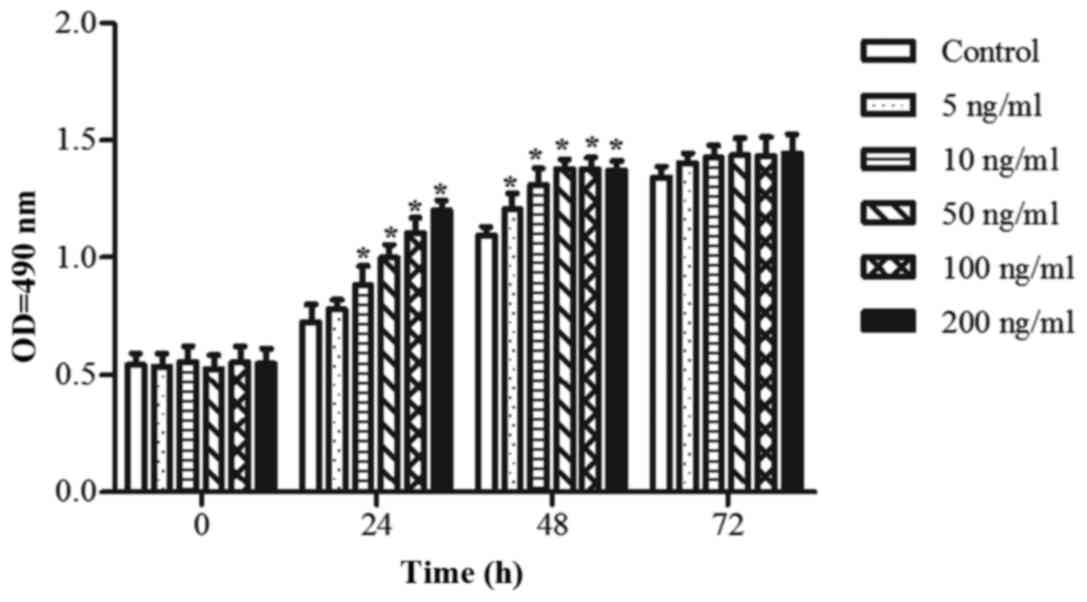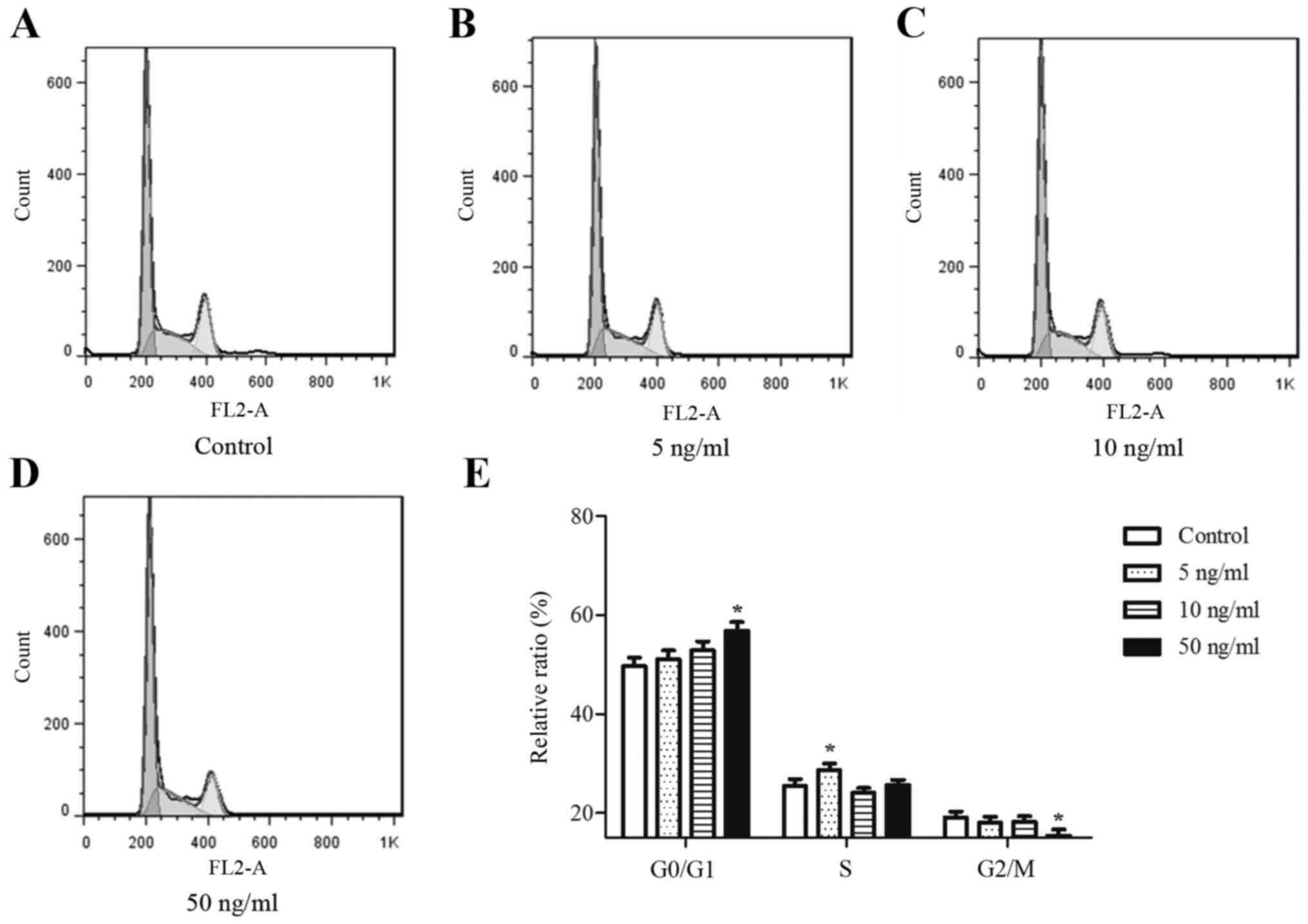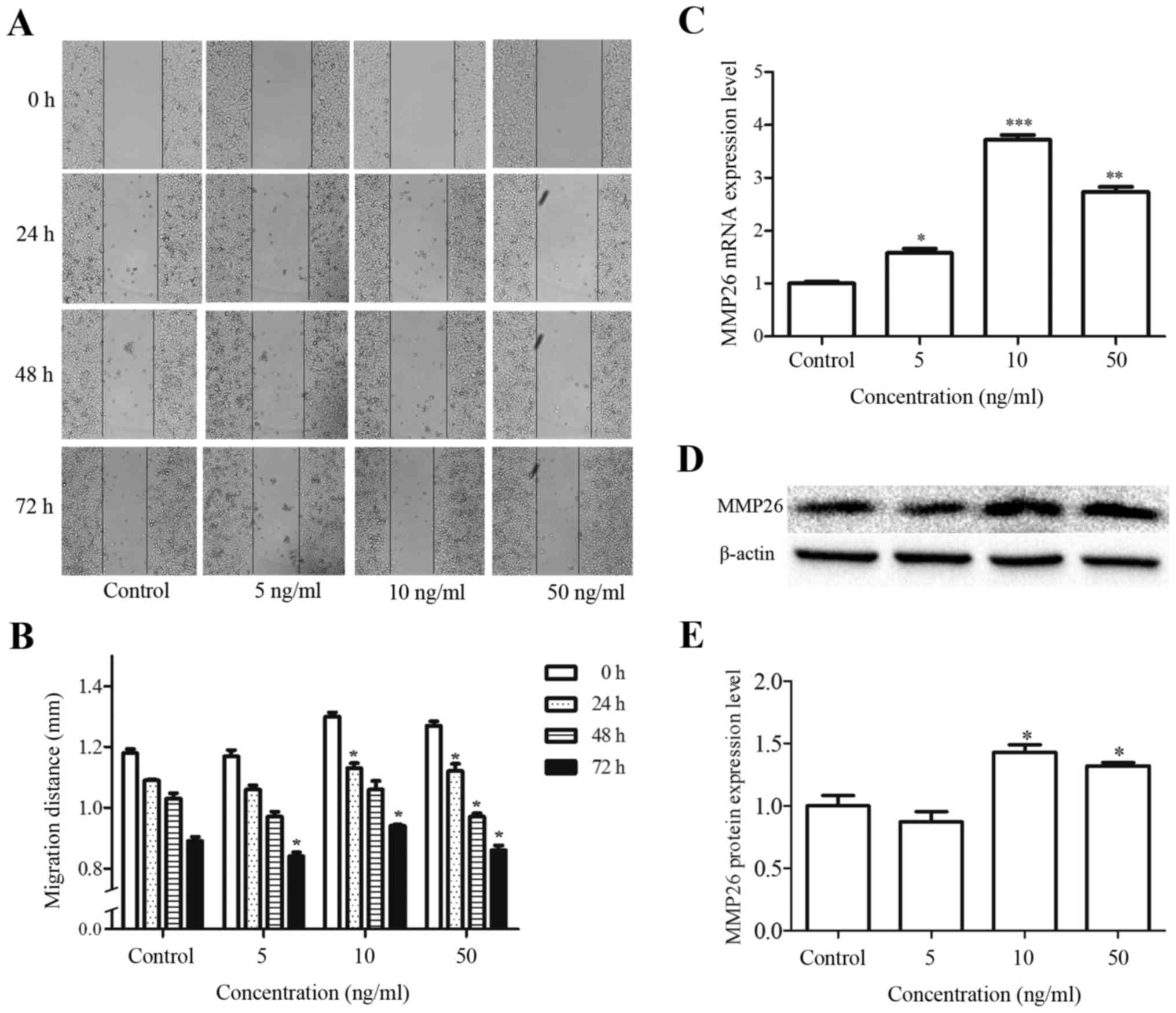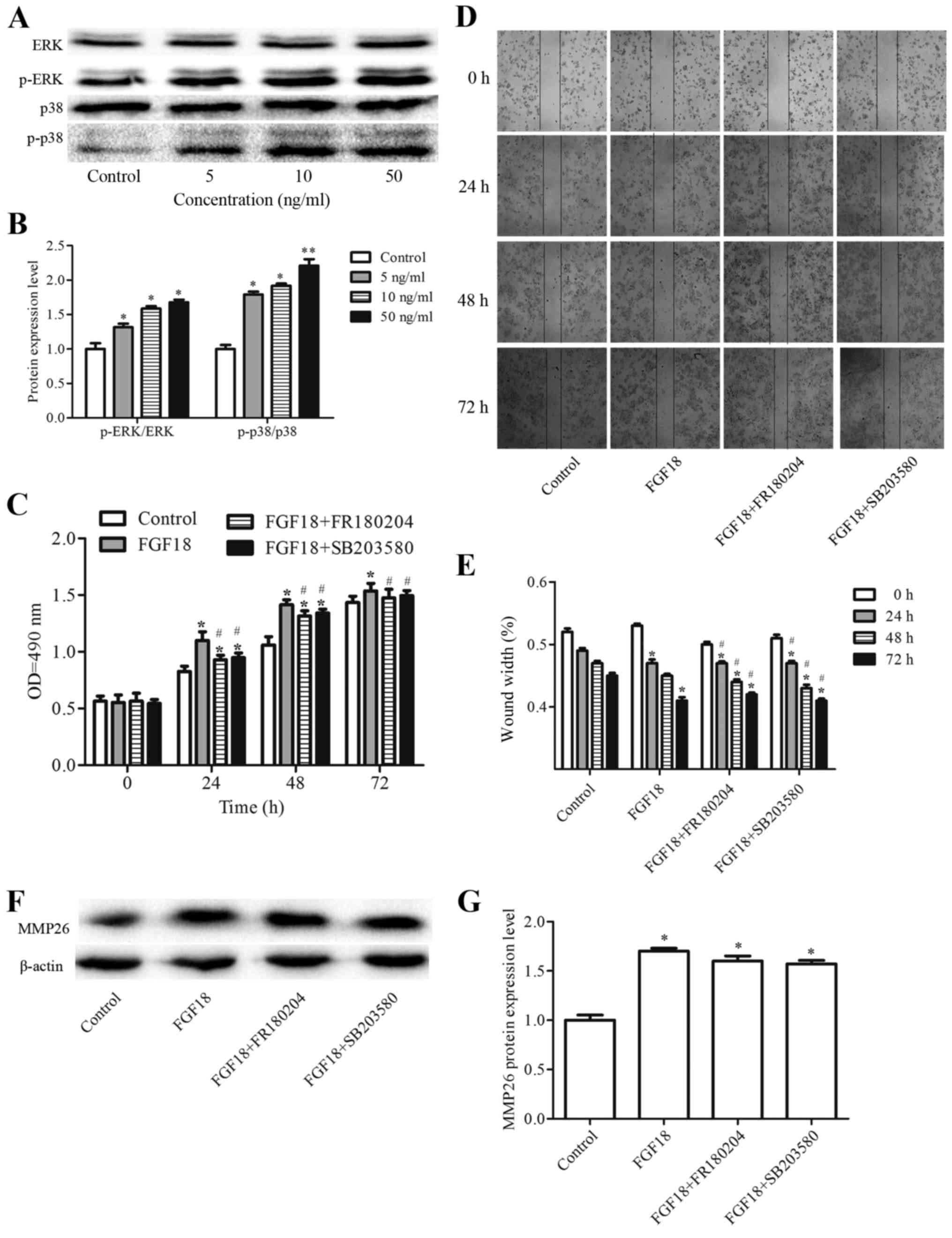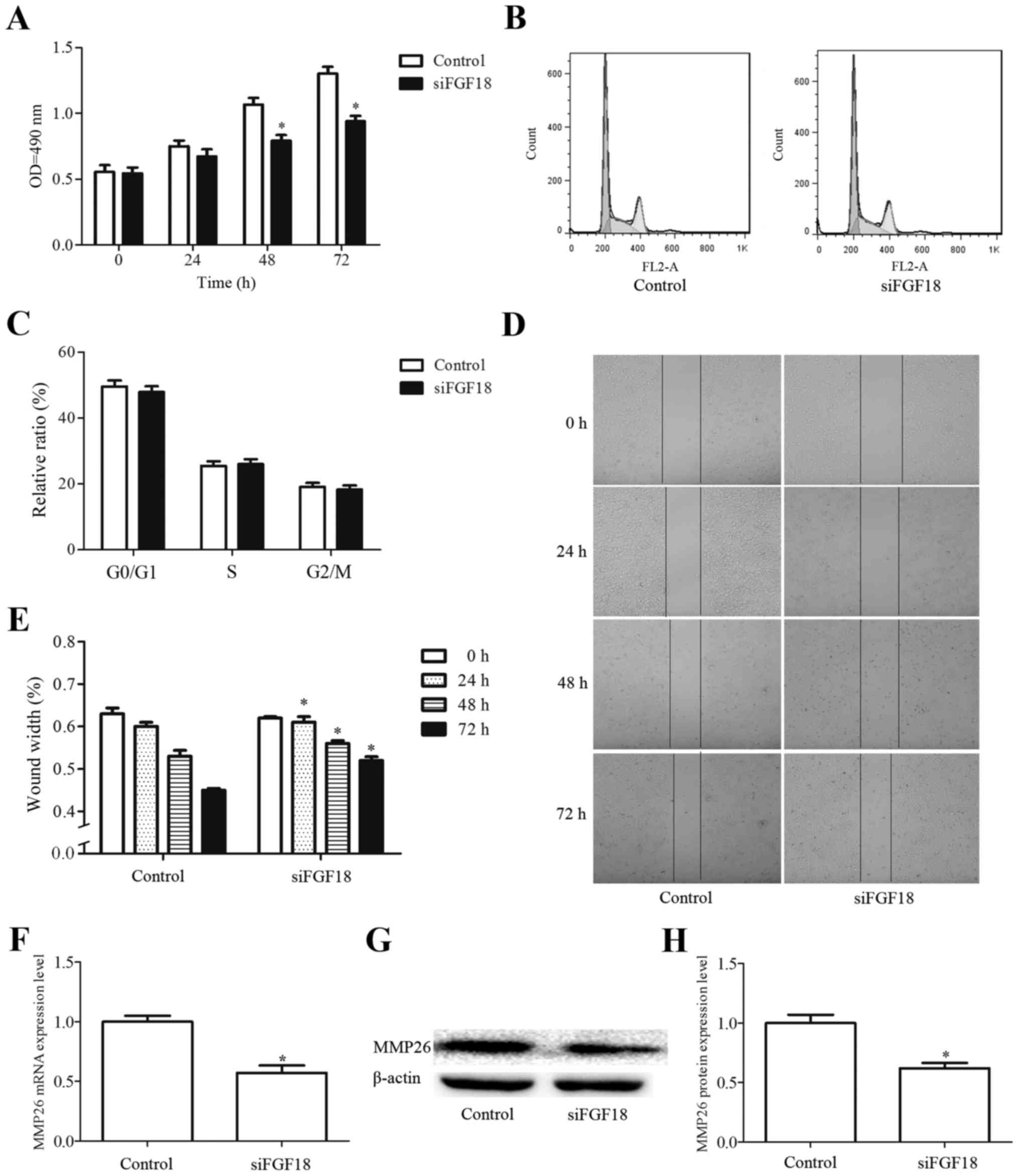Fibroblast growth factor 18 promotes proliferation and migration of H460 cells via the ERK and p38 signaling pathways
- Authors:
- Published online on: December 7, 2016 https://doi.org/10.3892/or.2016.5301
- Pages: 1235-1242
Abstract
Introduction
Lung cancer is the leading cause of cancer-associated mortality in the United States, with 157,000 cases of lung cancer-associated mortality in 2010 and 160,000 people in 2013, accounting for 26 and 28% of all female and male cancer-associated deaths, respectively (1,2). Lung cancer is classified into two main histological types: Non-small cell lung cancer (NSCLC) and small cell lung cancer (SCLC), accounting for 87% and 13% of all lung cancer cases, respectively (3). The predominant histological subtypes of NSCLC are adenocarcinoma (50–60%), squamous cell carcinoma (30–35%) and large-cell carcinoma (5–10%) (4). At present despite improvements in the diagnosis and treatment of lung cancer, factors such as postoperative recurrence and metastatic infiltration mean the prognosis of patients with lung cancer is still poor. However, the precise mechanisms of cancer recurrence and metastasis remain unclear.
The family of fibroblastic growth factors (FGF) has 23 identified members, which bind with 4 FGF receptor (FGFR) ligands, consisting of an extracellular portion, a transmembrane region and an intracellular domain. FGF family members are involved in cell growth, differentiation, morphogenesis, tissue repair, inflammation, angiogenesis, tumor growth and numerous developmental processes including embryonic and skeletal development (5–9). As such, the role of the FGF family has been widely studied during tumor growth and metastasis and has been shown to increase the proliferation, motility and invasiveness of a range of cell types (10,11). FGF18 has been demonstrated to serve an important role in skeletal growth and limb development, potentially through the modulation of osteoblasts, chondrocytes, and osteoclasts (12,13). Furthermore, FGF18 expression was upregulated in colon cancer and ovarian cancer, and increased expression of FGF18 mRNA and protein is associated with tumor progression and poor overall survival in patients (14–16).
Mitogen activated protein kinase (MAPK) is an intracellular signaling pathway, with physiological functions including cell proliferation, apoptosis and differentiation. The extracellular signal-regulated kinase (ERK) signaling pathway, which is one of the MAPKs, plays the role of proliferation, migration, differentiation (17). FGF activated FGFRs then activate a number of downstream signaling pathways, including ERK and p38, phospholipase Cγ, protein kinase C and phosphatidylinositol 3-kinase (11,17,18). The majority of these signaling pathways are involved in the growth and metastasis of cancer cells. In the present study, we aimed to investigate the effect of FGF18 and short interfering RNA (siRNA)-FGF18 on the proliferation and migration of NSCLC cells, in addition to the underlying mechanisms.
Materials and methods
Cell culture
The H460 human NSCLC line was obtained from Chemical Biology Research Center (Wenzhou Medical University, Wenzhou, China). The cells were cultured in Roswell Park Memorial Institute (RPMI)-1640 medium (Gibco; Thermo Fisher Scientific, Inc., Waltham, MA, USA) containing 10% fetal bovine serum (Gibco; Thermo Fisher Scientific, Inc.), and 1% antibiotic-antimycotic (Gibco) at 37°C and 10% CO2.
Cell proliferation assay
A 3-(4,5-dimethylthiazol-2-yl)-2, 5-diphenyltetrazolium bromide (MTT) assay (Beyotime Institute of Biotechnology, Haimen, China) was used to determine the proliferation of H460 cells. The cells (4,000 cells/well) were seeded and cultured for 24 h in 96-well plates, and serum-free medium was added for 4 h, following which cells were stimulated with (0, 5, 10, 50, 100 and 200 ng/ml rhFGF18 (Bioreactor, Wenzhou, China) (19), 5 µmol ERK inhibitor (FR180204, Sigma-Aldrich), 5 µmol p38 inhibitor (SB203580, Sigma-Aldrich) and further incubated for 0, 24, 48 and 72 h. Subsequently, 20 µl of 5 mg/ml MTT (BioSharp, Hefei, China) was added to each well, the plate was incubated for 4 h and the absorbance at 490 nm (SpectraMax M2, Molecular Devices, Sunnyvale, CA, USA) was subsequently detected. In each group, three wells were measured for cell proliferation; the data are shown as the mean ± standard deviation (SD).
Cell cycle analysis
Cell cycle distribution was analyzed by propidium iodide (PI; BD Bioscience, San Jose, CA, USA) staining and flow cytometry. The H460 cells (20,000 cells/well) were seeded in 6-well plates and exposed to (0, 5, 10 and 50 ng/ml) FGF18 for 48 h. The cells were then harvested, fixed with 70% ice-cold ethanol, and stored at −20°C until analysis. After fixation, the cells were washed twice with cold phosphate-buffered saline (PBS) and centrifuged, following which the supernatants were removed. The pellet was resuspended and stained with PBS containing 50 mg/ml PI and 100 mg/ml RNaseA for 20 min in the dark. The DNA content was analyzed by flow cytometry using a FACSCalibur instrument and CellQuest software (BD Bioscience). The cell cycle data were analyzed using FlowJo 7.6 software, version (FlowJo, LLC, Ashland, OR, USA) and the data are shown as the mean ± SD.
Would healing assay
H460 cells were seeded into 6-well plates and were cultured at 37°C until they reached 100% confluence. The monolayers were scratched with a pipette tip and cultured under normal conditions or (0, 5, 10 and 50 ng/ml) FGF18 after the cell fragments were removed by washing with PBS. Images (Olympus IX51, magnification: ×40, Olympus Corporation, Tokyo, Japan) were captured at 0, 24, 48 and 72 h, and the data are shown as the migration distance between the two edges. The migration distance was assessed using ToupView software. The data are shown as the mean ± SD.
Cell transfection
Chemically synthesized FGF18 siRNA (Guangzhou Ribobio Co., Ltd., Guangzhou, China) were used for transfection. To make the transfection mixture, riboFECT™ CP buffer and siRNA were first prepared in 1.5 ml micro-centrifuge tubes. Subsequently, they were mixed with riboFECT CP reagent and allowed to incubate at room temperature for 15 min. Cells in 6-well plates were washed with PBS twice and the transfection mixture was added to the cells. The plates were gently rocked following which the medium was added to the cells. Subsequently, the H460 cells were transfected with FGF18 siRNA for 48 h.
Reverse transcription-quantitative polymerase chain reaction (RT-qPCR)
Total RNA was isolated from the cells using a TRIzol plus kit (Takara Bio, Inc., Otsu, Japan) according to the manufacturer's protocol. RNA was reverse transcribed using PrimeScript™ RT Master Mix (Takara Bio, Inc.) according to the manufacturer's instructions. The PCR amplifications were performed for 40 cycles of 94°C for 30 sec, 60°C for 30 sec, and 72°C for 30 sec, using a Applied CFX96™ Real-Time PCR (Bio-Rad Laboratories, Inc., Hercules, CA, USA) with 1.0 µl of cDNA and SYBR Green Real-time PCR Master Mix (Takara Bio, Inc.). Data were collected and analyzed by Bio-Rad CFX Manager software. The expression level of each sample was internally normalized against that of the glyceraldehyde 3-phosphate dehydrogenase (GAPDH). The relative quantitative value was calculated using the 2−∆∆Ct method (20). Each experiment was performed in triplicate. The primers used in real-time PCR were as follow: Matrix metalloproteinase 26 (MMP26), forward 5′-GGCCAGGTGGTATCTTAGGC-3′ and reverse 5′-AGCTGACCAGTGTTCATTCTTG-3′; FGF18 forward sequence 5′-GGACATGTGCAGGCTGGGCTA-3′ and reverse 5′-GTAGAATTCCGTCTCCTTGCCCTT-3′; and GAPDH forward 5′-ACAACAGCCTCAAGATCATCAG-3′ and reverse 5′-GGTCCACCACTGACACGTTG-3′. The primers were designed and chemically synthesized in Genewiz, Inc. (South Plainfield, NJ, USA).
Western blotting
Cell samples were digested in lysis buffer (Beyotime Institute of Biotechnology), and the protein concentrations were measured using the bicinchoninic acid protein assay kit (Beyotime Institute of Biotechnology). Total protein (40 µg) was resolved by 12% odium dodecyl sulfate-polyacrylamide gel electrophoresis and transferred onto 0.22 µm polyvinylidene fluoride membranes and probed with the following primary antibodies, overnight at −4°C: Anti-human FGF18 and anti-MMP26 (Abcam, Cambridge, MA, USA), anti-phosphorylated (p)-ERK1/2, anti-ERK1/2, anti-p-p38, anti-p38 and anti-β-actin (Cell Signaling Technology, Inc., Danvers, MA, USA). Following three washes, the membranes were incubated with horseradish peroxidase conjugated anti-rabbit IgG secondary antibodies (Santa Cruz Biotechnology, Inc., Dallas, TX, USA) for 1 h at room temperature. The detection of specific proteins was carried out using an enhanced chemiluminscence western blotting kit (Santa Cruz Biotechnology, Inc.).
Statistical analysis
For each experiment, three independent replicates were performed. All data are expressed as the mean ± SD. Statistical evaluation was conducted using Student's test. The intergroup differences were compared using one-way analysis of variance followed by Dunnett's test. P<0.05 was considered to indicate a statistically significant difference. *P<0.05, **P<0.0l, and ***P<0.001 vs. control.
Results
FGF18 promotes the proliferation of H460 cells
A cell proliferation assay was used to investigate the effect of FGF18 on H460 cells. Cells were treated with 0, 5, 10, 50, 100 and 200 ng/ml of FGF18 for 0, 24, 48 or 72 h. As shown in Fig. 1, stimulation with FGF18 significantly increased H460 cell proliferation in a time and concentration-dependent manner. At concentrations of 5, 10 and 50 ng/ml, FGF18 had a remarkable effect on H460 cell proliferation. When time reached 72 h, however, FGF18 was unable to affect the growth as a consequence of the too long culture. The results suggest that FGF18 has a role in promoting the proliferation of lung cancer cells.
FGF18 promotes cell cycle progression
Different concentrations of FGF18 promoted proliferation of H460 cells, indicating that FGF18 may alter cell cycle-related events in H460 cells. Therefore, the effects of FGF18 on cell cycle kinetics were investigated to understand how FGF18 may regulate the cell cycle. As shown in Fig. 2A-E, stimulation with FGF18 increased the proportion of cells in the G0/G1 phase and reduced the proportion of cells in the S or G2/M phases compared with untreated H460 cells. These results suggest that the FGF18-mediated increase in H460 cell proliferation occurred via increasing the proportion of cells in G0/G1 phase and S phase.
FGF18 promotes the migration of H460 cells and modulates the migration-related factor
A wound healing assay was used to investigate the effects of FGF18 on cell migration. Following treatment with 5, 10 and 50 ng/ml FGF18 for 24, 48 or 72 h, the migration distance was increased in H460 cells compared with the control untreated cells (Fig. 3A and B). Additionally, the effect of FGF18 on the expression of the migration-related factor MMP26, was investigated in H460 cells. As shown in the results of the western blot and RT-qPCR assays in Fig. 3C and E, FGF18 increased the mRNA and protein expression levels of MMP26 in a dose-dependent manner, particularly at 10 and 50 ng/ml concentrations. These results suggest that FGF18 promotes the migration of H460 cells and affects the migration-related factor MMP26.
ERK and p38 signaling are involved in FGF18 mediated promotion of proliferation and migration in H460 cells
The above findings indicate that FGF18 significantly promotes the proliferation and migration of H460 cells. Moreover, the expression of MMP26 was promoted by FGF18 in H460 cells. However, the underlying mechanisms responsible for the effect of FGF18 are unclear. Hence, the effect of FGF18 on the signal transduction of MAPKs was further assessed by western blot analysis. H460 cells were treated with 5, 10 and 50 ng/ml FGF18 for 48 h, and the total protein lysates collected and subjected to western blotting with p-ERK1/2, ERK1/2, p38 MAPK and p-p38 MAPK antibodies. As shown in Fig. 4A and B, FGF18 increased the levels of p-ERK1/2 and p-p38. To address which of these pathways are regulating these effects, we used the specific inhibitors, FR180204 (ERK inhibitor) and SB203580 (p38 inhibitor). Results showed that the effect of FGF18 stimulation on proliferation and migration was inhibited by application of 5 µmol/l FR180204 and 5 µmol/l SB203580 (Fig. 4C-E). However, MMP26 protein did not change by the inhibitors (Fig. 4F and G). These data suggest that the effects of FGF18 in proliferation and migration of H460 cells is potentially mediated via modulations of the ERK1/2 pathway and p38 MAPK pathways.
FGF18 expression in H460 cells is downregulated by FGF18-siRNA
The RT-qPCR results indicated that the mRNA expression of FGF18 in H460 cells transfected with siFGF18 was reduced compared with control group (Fig. 5A). Additionally, FGF18 protein expression was examined using western blot analyses (Fig. 5B and C), with the results consistent with the mRNA data. These results demonstrate the successful knockdown of FGF18 using siRNA.
FGF18 siRNA inhibits cell proliferation and migration in the ERK and p38 signaling pathways in H460 cells
The proliferation and migration of cancer cells are key steps in the progression of cancer. Following cell transfection, the effect of FGF18 siRNA on cell proliferation was evaluated in H460. The OD values were significantly reduced in the siFGF18 group compared with the control group (Fig. 6A), indicating that FGF18 siRNA inhibited cell proliferation in H460 cells. However, as shown in Fig. 6B and C, the siFGF18 group did not exhibit alterations in the cell cycle of H460 cells. In addition, the migration distance of siFGF18-transfected H460 cells was reduced compared with the control groups (Fig. 6D and E). Expression of MMP26 gene and protein was additionally significantly reduced following siFGF18, with a 57% gene inhibition rate and 62% protein inhibition rate, respectively (Fig. 6F-H). The levels of p-ERK and p-p38 protein were significantly lower in the siFGF18 group compared with the cells in the control group (Fig. 6I and J). Taken together, these results suggest that FGF18 siRNA is able to repress cell proliferation and migration, and this effect is potentially mediated through the ERK and pP38 signaling pathways in H460 cells.
Discussion
In NSCLC, the FGF and FGFR family has been demonstrated to be associated with its progression. FGF1 expression has been identified in the cytoplasm, or both cytoplasm and nucleus of NSCLC cells, and high expression levels of FGF1 in cancer cells were significantly correlated with larger primary tumor size and vascular invasion (21). FGF9-FGFR3 signaling has a complex role in the initiation, growth and propagation of lung cancer (22). Nevertheless, the role of FGF18 has not been previously studied in the context of lung cancer. Previous studies have indicated that elevated expression of FGF18 promotes the growth of colon cancer cells in culture (23), and demonstrated the pronounced oncogenic effect of FGF18 on ovarian tumor growth and metastasis (16). These observations are in agreement with our conclusion that FGF18 promoted the proliferation and migration of H460 cells. The present study, to the best of our knowledge, is the first report of the effects of FGF18 on NSCLC cells.
A number of studies have shown that MAPKs (JNK1/2, ERK1/2, and p38) are involved in the growth, migration, and alterations in MMPs activity (24,25) in various cancers including lung, prostate, colorectal and ovarian cancer (26–30). Furthermore, the ERK signaling pathway in addition to the p38 signaling pathway may regulate numerous factors that are associated with cancer progression and poor prognosis in NSCLC (31–33). The MMP family comprises 24 zinc-dependent endopeptidases, and serves important roles in tumor metastasis and MMP26 is associated with the invasion and metastasis of non-small cell lung cancer (34–36). It has been reported that the expression of MMPs is regulated by MAPK pathways (37,38). To confirm whether ERK and p38 signaling pathway is involved in this situation, we applied specific inhibitors for ERK and p38, respectively, to the FGF18-stimulated H460 cells. We found that the inhibition of ERK and p38 decreased the proliferation and migration in response to FGF18 stimulation, while the activation of MMP26 did not change, suggesting that the activation of ERK and p38 signaling may cause an increase in proliferation and migration of H460 cells without MMP26 protein. However, using either ERK inhibitor or p38 inhibitor could not completely inhibit the H460 proliferation and migration, which may be due to the presence and activation of another signal transduction cascade. The present study suggests that the stimulation with FGF18 in NSCLC cells activated the ERK and p38 signaling pathways, and additionally upregulated the level of MMP26. This suggests that the underlying molecular mechanism may involve activated ERK and p38 signaling pathways in NSCLC cells inducing proliferative and migratory signals.
The present study additionally demonstrated that the transfection of cancer cells with siRNA targeted against the FGF18 gene can effectively reduce FGF18 gene expression and suppress the effects on proliferation, and migration in H460 cells. However, the effect of siFGF18 on proliferation was not accompanied by alterations in the cell cycle. Therefore further studies are required to explore the mechanisms of FGF18 on proliferation. Western blot analysis was used to investigate the expression of ERK, p38 and MMP26 in human H460 cells following siRNA-FGF18 treatment for 48 h, which demonstrated marked inhibition of the ERK and p38 signaling pathways. These results imply that the use of siRNA holds potential in treating lung cancer cells, and that the FGF18 gene may be a potential therapeutic target in NSCLC.
In conclusion, the present study suggests that FGF18 serves a key role in the proliferation and migration of NSCLC cells by regulating the ERK, p38 signaling pathways and MMP26 protein expression levels, indicating that FGF18 may represent a potential molecular drug target in NSCLC. Nevertheless, further studies using NSCLC cell lines and investigating the in vivo physiological role of FGF18 are required.
Acknowledgements
This work was supported by grants of the National Key New Drug Foundation of China (no. 2013ZX09103-003-005), Wenzhou Scientific Innovation Grant to Dr Chao Jiang, and Scientific Research Fund of Wenzhou Medical University, project number: QTJ16003.
Glossary
Abbreviations
Abbreviations:
|
FGF18 |
fibroblast growth factor 18 |
|
ERK |
extracellular signal-regulated kinase |
|
MMP26 |
matrix metalloproteinase 26 |
|
NSCLC |
non-small cell lung cancer |
|
SCLC |
small cell lung cancer |
|
FGF |
fibroblastic growth factors |
|
FGFR |
fibroblastic growth factor receptor |
|
MAPK |
mitogen activated protein kinase |
|
siRNA |
short interfering RNA |
|
PI |
propidium iodide |
References
|
Jemal A, Siegel R, Xu J and Ward E: Cancer statistics, 2010. CA Cancer J Clin. 60:277–300. 2010. View Article : Google Scholar : PubMed/NCBI | |
|
Siegel R, Naishadham D and Jemal A: Cancer statistics, 2013. CA Cancer J Clin. 63:11–30. 2013. View Article : Google Scholar : PubMed/NCBI | |
|
Travis WD, Brambilla E, Nicholson AG, Yatabe Y, Austin JH, Beasley MB, Chirieac LR, Dacic S, Duhig E, Flieder DB, et al: The 2015 World Health Organization Classification of Lung Tumors: Impact of genetic, clinical and radiologic advances since the 2004 classification. J Thorac Oncol. 10:1243–1260. 2015. View Article : Google Scholar : PubMed/NCBI | |
|
Ettinger DS, Akerley W, Bepler G, Blum MG, Chang A, Cheney RT, Chirieac LR, D'Amico TA, Demmy TL, Ganti AK, et al: Non-small cell lung cancer. J Natl Compr Canc Netw. 8:740–801. 2010.PubMed/NCBI | |
|
Antoine M, Wirz W, Tag CG, Mavituna M, Emans N, Korff T, Stoldt V, Gressner AM and Kiefer P: Expression pattern of fibroblast growth factors (FGFs), their receptors and antagonists in primary endothelial cells and vascular smooth muscle cells. Growth Factors. 23:87–95. 2005. View Article : Google Scholar : PubMed/NCBI | |
|
Hu MC, Qiu WR, Wang YP, Hill D, Ring BD, Scully S, Bolon B, DeRose M, Luethy R, Simonet WS, et al: FGF-18, a novel member of the fibroblast growth factor family, stimulates hepatic and intestinal proliferation. Mol Cell Biol. 18:6063–6074. 1998. View Article : Google Scholar : PubMed/NCBI | |
|
Canalis E, McCarthy TL and Centrella M: Growth factors and cytokines in bone cell metabolism. Annu Rev Med. 42:17–24. 1991. View Article : Google Scholar : PubMed/NCBI | |
|
Liu Z, Xu J, Colvin JS and Ornitz DM: Coordination of chondrogenesis and osteogenesis by fibroblast growth factor 18. Genes Dev. 16:859–869. 2002. View Article : Google Scholar : PubMed/NCBI | |
|
Dailey L, Ambrosetti D, Mansukhani A and Basilico C: Mechanisms underlying differential responses to FGF signaling. Cytokine Growth Factor Rev. 16:233–247. 2005. View Article : Google Scholar : PubMed/NCBI | |
|
Turner N and Grose R: Fibroblast growth factor signalling: From development to cancer. Nat Rev Cancer. 10:116–129. 2010. View Article : Google Scholar : PubMed/NCBI | |
|
Beenken A and Mohammadi M: The FGF family: Biology, pathophysiology and therapy. Nat Rev Drug Discov. 8:235–253. 2009. View Article : Google Scholar : PubMed/NCBI | |
|
Marie PJ: Fibroblast growth factor signaling controlling osteoblast differentiation. Gene. 316:23–32. 2003. View Article : Google Scholar : PubMed/NCBI | |
|
Moore EE, Bendele AM, Thompson DL, Littau A, Waggie KS, Reardon B and Ellsworth JL: Fibroblast growth factor-18 stimulates chondrogenesis and cartilage repair in a rat model of injury-induced osteoarthritis. Osteoarthritis Cartilage. 13:623–631. 2005. View Article : Google Scholar : PubMed/NCBI | |
|
Sonvilla G, Allerstorfer S, Stättner S, Karner J, Klimpfinger M, Fischer H, Grasl-Kraupp B, Holzmann K, Berger W, Wrba F, et al: FGF18 in colorectal tumour cells: Autocrine and paracrine effects. Carcinogenesis. 29:15–24. 2007. View Article : Google Scholar : PubMed/NCBI | |
|
Koneczny I, Schulenburg A, Hudec X, Knöfler M, Holzmann K, Piazza G, Reynolds R, Valent P and Marian B: Autocrine fibroblast growth factor 18 signaling mediates Wnt-dependent stimulation of CD44-positive human colorectal adenoma cells. Mol Carcinog. 54:789–799. 2015. View Article : Google Scholar : PubMed/NCBI | |
|
Wei W, Mok SC, Oliva E, Kim SH, Mohapatra G and Birrer MJ: FGF18 as a prognostic and therapeutic biomarker in ovarian cancer. J Clin Invest. 123:4435–4448. 2013. View Article : Google Scholar : PubMed/NCBI | |
|
Rubinfeld H and Seger R: The ERK cascade: A prototype of MAPK signaling. Mol Biotechnol. 31:151–174. 2005. View Article : Google Scholar : PubMed/NCBI | |
|
Krejci P, Prochazkova J, Bryja V, Kozubik A and Wilcox WR: Molecular pathology of the fibroblast growth factor family. Hum Mutat. 30:1245–1255. 2009. View Article : Google Scholar : PubMed/NCBI | |
|
Song L, Huang Z, Chen Y, Li H, Jiang C and Li X: High-efficiency production of bioactive recombinant human fibroblast growth factor 18 in Escherichia coli and its effects on hair follicle growth. Appl Microbiol Biotechnol. 98:695–704. 2014. View Article : Google Scholar : PubMed/NCBI | |
|
Livak KJ and Schmittgen TD: Analysis of relative gene expression data using real-time quantitative PCR and the 2(−Delta Delta C(T)) methods. Methods. 25:402–408. 2001. View Article : Google Scholar : PubMed/NCBI | |
|
Li J, Wei Z, Li H, Dang Q, Zhang Z, Wang L, Gao W, Zhang P, Yang D, Liu J, et al: Clinicopathological significance of fibroblast growth factor 1 in non-small cell lung cancer. Hum Pathol. 46:1821–1828. 2015. View Article : Google Scholar : PubMed/NCBI | |
|
Arai D, Hegab AE, Soejima K, Kuroda A, Ishioka K, Yasuda H, Naoki K, Kagawa S, Hamamoto J, Yin Y, et al: Characterization of the cell of origin and propagation potential of the fibroblast growth factor 9-induced mouse model of lung adenocarcinoma. J Pathol. 235:593–605. 2015. View Article : Google Scholar : PubMed/NCBI | |
|
Shimokawa T, Furukawa Y, Sakai M, Li M, Miwa N, Lin YM and Nakamura Y: Involvement of the FGF18 gene in colorectal carcinogenesis, as a novel downstream target of the beta-catenin/T-cell factor complex. Cancer Res. 63:6116–6120. 2003.PubMed/NCBI | |
|
Tang SW, Yang TC, Lin WC, Chang WH, Wang CC, Lai MK and Lin JY: Nicotinamide N-methyltransferase induces cellular invasion through activating matrix metalloproteinase-2 expression in clear cell renal cell carcinoma cells. Carcinogenesis. 32:138–145. 2011. View Article : Google Scholar : PubMed/NCBI | |
|
McCubrey JA, Steelman LS, Chappell WH, Abrams SL, Wong EW, Chang F, Lehmann B, Terrian DM, Milella M, Tafuri A, et al: Roles of the Raf/MEK/ERK pathway in cell growth, malignant transformation and drug resistance. Biochim Biophys Acta. 1773:1263–1284. 2007. View Article : Google Scholar : PubMed/NCBI | |
|
Sun L, Zhang Q, Li Y, Tang N and Qiu X: CCL21/CCR7 up-regulate vascular endothelial growth factor-D expression via ERK pathway in human non-small cell lung cancer cells. Int J Clin Exp Pathol. 8:15729–15738. 2015.PubMed/NCBI | |
|
Han Y, Luo Y, Wang Y, Chen Y, Li M and Jiang Y: Hepatocyte growth factor increases the invasive potential of PC-3 human prostate cancer cells via an ERK/MAPK and Zeb-1 signaling pathway. Oncol Lett. 11:753–759. 2016.PubMed/NCBI | |
|
Li L, Duan T, Wang X, Zhang RH, Zhang M, Wang S, Wang F, Wu Y, Huang H and Kang T: KCTD12 Regulates colorectal cancer cell stemness through the ERK pathway. Sci Rep. 6:204602016. View Article : Google Scholar : PubMed/NCBI | |
|
Xia ZX, Li ZX, Zhang M, Sun LM, Zhang QF and Qiu XS: CARMA3 regulates the invasion, migration, and apoptosis of non-small cell lung cancer cells by activating NF-κB and suppressing the P38 MAPK signaling pathway. Exp Mol Pathol. 100:353–360. 2016. View Article : Google Scholar : PubMed/NCBI | |
|
Bai RX, Wang WP, Zhao PW and Li CB: Ghrelin attenuates the growth of HO-8910 ovarian cancer cells through the ERK pathway. Braz J Med Biol Res. 49(pii): S0100-879X2016000300602. 2016. | |
|
Kim JH, Cho EB, Lee J, Jung O, Ryu BJ, Kim SH, Cho JY, Ryou C and Lee SY: Corrigendum to <Emetine inhibits migration and invasion of human non-small-cell lung cancer cells via regulation of ERK and p38 signaling pathways>. Chem Biol Interact. Nov 2–2015.(Epub ahead of print). doi: 10.1016/j.cbi.2015.10.023. | |
|
Zhang Y, Zhao J, Qiu L, Zhang P, Li J, Yang D, Wei X, Han Y, Nie S and Sun Y: Co-expression of ILT4/HLA-G in human non-small cell lung cancer correlates with poor prognosis and ILT4-HLA-G interaction activates ERK signaling. Tumour Biol. 37:11187–11198. 2016. View Article : Google Scholar : PubMed/NCBI | |
|
Zhang C, Shi J, Mao SY, Xu YS, Zhang D, Feng LY, Zhang B, Yan YY, Wang SC, Pan JP, et al: Role of p38 MAPK in enhanced human cancer cells killing by the combination of aspirin and ABT-737. J Cell Mol Med. 19:408–417. 2015. View Article : Google Scholar : PubMed/NCBI | |
|
Zhang Y, Zhao H, Wang Y, Lin Y, Tan Y, Fang X and Zheng L: Non-small cell lung cancer invasion and metastasis promoted by MMP-26. Mol Med Rep. 4:1201–1209. 2011.PubMed/NCBI | |
|
Ming SH, Sun TY, Xiao W and Xu XM: Matrix metalloproteinases-2, −9 and tissue inhibitor of metallo-proteinase-1 in lung cancer invasion and metastasis. Chin Med J (Engl). 118:69–72. 2005.PubMed/NCBI | |
|
Zhao D, Lu Y, Yang C, Zhou X and Xu Z: Activation of FGF receptor signaling promotes invasion of non-small-cell lung cancer. Tumour Biol. 36:3637–3642. 2015. View Article : Google Scholar : PubMed/NCBI | |
|
Wu X, Yang L, Zheng Z, Li Z, Shi J, Li Y, Han S, Gao J, Tang C, Su L, et al: Src promotes cutaneous wound healing by regulating MMP-2 through the ERK pathway. Int J Mol Med. 37:639–648. 2016.PubMed/NCBI | |
|
Xia Y, Lian S, Khoi PN, Yoon HJ, Joo YE, Chay KO, Kim KK and Do Jung Y: Chrysin inhibits tumor promoter-induced MMP-9 expression by blocking AP-1 via suppression of ERK and JNK pathways in gastric cancer cells. PLoS One. 10:e01240072015. View Article : Google Scholar : PubMed/NCBI |



